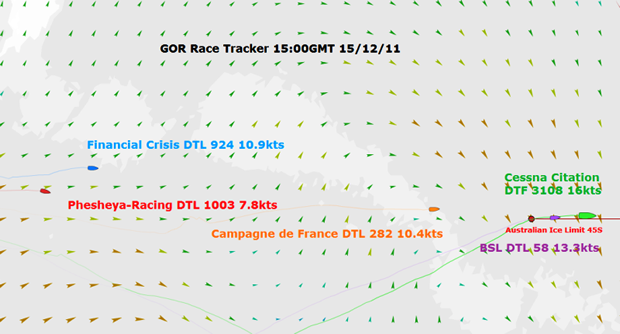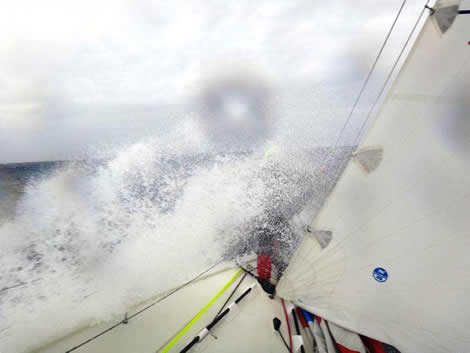Merron and Mabire bracing for Southern Ocean gale
As the low pressure system stalking the Global Ocean Race fleet continues to rumble east across the Roaring Forties, it has left the two westerly boats, Financial Crisis and Phesheya-Racing, battered and bruised before moving on the give Campagne de France a hammering. On Thursday morning, the two leading boats, Cessna Citation and BSL, reached the western end of the GOR’s Australian Ice Limit at 45°S, turning round the virtual mark before the heavy breeze arrived, immediately freeing off and accelerating dramatically in the building northwesterly wind ahead of the Southern Ocean depression.
At 15:00 GMT today, Financial Crisis in fourth place was making good progress, leading Phesheya-Racing by 79 miles and separated from the leaders by just over 900 miles, but the effects of the storm were heavily imprinted on Marco Nannini and Hugo Ramon: “Sailing through the stormy conditions of yesterday and the day before was wet, tiring, cold and uncomfortable,” confirms the 33 year-old Italian skipper, Marco Nannini. “We went down to storm jib and three reefs in the mainsail and beat for hours on end in 35-40 knots with gusts to 45. Through the worst of the winds, when it was blowing solid 40 knots under a rainy sky the colour of lead and charcoal, rain drops would hit your face with such violence they hurt; they hurt your eyeballs when you tried to look forward and any trip to the cockpit involved a total soaking.”
Conditions were worsened by the Akilaria frequently becoming airborne: “The sea state was horrendous as for some reason we keep coming across random surface currents,” Nannini continues. “Sometimes in favour, sometimes against of up to two knots and in the high winds, these currents contributed to stirring a very nasty sea with cross waves and no apparent pattern or sense,” he reports. “Occasionally, the boat would climb a wave from nowhere at right angles and fall from the top into a trough with the loudest of crashes.” With nerves jangling from the repetitive and violent slamming, Nannini and Ramon were on high alert for disaster: “I kept checking the floor and keel box for any signs of damage, maybe I was being paranoid, but with the closest piece of land nearly 2,000 miles away you tend to worry about these things…”
Early on Thursday, the storm jib was replaced by the staysail and a reef was shaken out. “Then it was time for the Solent and now, finally, we’re flying our smallest spinnaker, the A5, and the spirits are definitely much higher although both Hugo and I are tired, the stormy conditions take their toll,” reports Nannini. Averaging 10.9 knots on Thursday afternoon with 4,000 miles of Leg 2 remaining, progress is again being made. “The computer has recalculated the expected date of arrival in Wellington and instead of some crazy date six months in the future, we finally show arriving in the early days of January - fingers crossed, that’s what will happen.”
Separated by around 50 miles at the height of the gale, Nannini and Ramon and the South African duo of Nick Leggatt and Phillippa Hutton-Squire on Phesheya-Racing shared similar, horrific conditions. For Leggatt and Hutton-Squire, two crash gybes in quick succession signalled it was time to dramatically reduce sail: “We went galloping down a wave at full tilt and got side swiped by a monster of a wave and crash gybed!” reported Phillippa Hutton-Squire on Thursday morning. The duo hove-to to assess any damage. “We were very lucky and everything was okay, but we decided it was time for a reef in the stay sail, so I took the helm and sailed deep down the monster waves while Nick put the reef in.” Despite two reefs in the mainsail and a reefed staysail, Phesheya-Racing was still flying at between ten and 12 knots: “I wanted to slow the boat as much as possible and keep the boat dry as we took off down the waves at incredible speed.” Fairly quickly, the call was made for another reef in the main: “I never really thought we would use the third reef,” says Hutton-Squire. “Even with the wind aft of the beam it was definitely needed as it was too wet and cold to sit there and drive.”
With Phesheya-Racing out of danger and back on track, Nick Leggatt has been assessing the weather ahead: “So far, the weather forecast for the week ahead is finally starting to look like a typical Southern Ocean pattern - whatever that might be!” notes Leggatt. “There appear to be a succession of cold fronts moving in from the west, towards the east, which will bring a rapid succession of strong winds and rain followed by lighter bits between the fronts,” he predicts. “So, some good running and reaching conditions to make a change from the beating we had to endure over the last couple of days.” At 15:00 GMT on Wednesday, Phesheya-Racing was making 7.8 knots, running on starboard gybe in heavy breeze. “Down here, we have to keep racing no matter what the conditions are, but the most pleasant conditions - if you can use that phrase - are in the relatively steady N or NW winds ahead of the cold fronts,” continues Leggatt. “As far as we are concerned, the ideal is about 18 knots of breeze and a moderate sea so that we make good, steady progress without undue risk to anything.”
While the co-skippers on Financial Crisis and Phesheya-Racing changed from holding on with both hands to using just one hand, 640 miles to the east, Halvard Mabire and Miranda Merron in third place on Campagne de France were bracing themselves: “The calm patch is far behind us and as the wind starts to build with the low pressure system chasing us,” reported Halvard Mabire on Thursday morning. “The barometer is in free fall to such an extent that we should really offer the poor machine a parachute!” Early on Thursday, speeds on the Franco-British team’s Pogo 40S² leapt to 12-knot averages. “The wind is coming from the port side and the conditions are becoming increasingly muscular,” adds Mabire. “The boat rebounds on waves and bangs very hard - sometimes we’re going just too fast and the bow burrows into the sea and the back end lifts clear of the water, but we have it under control,” he says reassuringly. “The wind oscillates between 25 and 30 knots, whereas the famous weather files are giving us 20 knots,” Mabire observes. “What’s it going to be like when the files give us 35 knots? Probably 40 to 50?” This inaccuracy is a bête noire for the French skipper: “The wind files always underestimate reality and it’s something I’ve always noticed over the years,” he notes. “I’ll say it again, but why can’t the egghead geniuses who make these computer programmes get it right?” Despite the weather files, Mabire and Merron were making over-12 knot averages on Thursday, slowing slightly to 10.4 knots at 15:00 GMT, trailing second-placed BSL by 224 miles on with 170 miles remaining to the Australian Ice Limit.
At the head of the fleet with Cessna Citation, Conrad Colman and Artemis Offshore Academy sailor, Sam Goodchild reached the western end of the GOR’s Australian Ice Limit at 08:30 GMT on Thursday as the nort-westerly breeze ahead of the low pressure system built towards 30 knots. As is habitual with the New Zealand-British duo, the foot was firmly planted on the floor and speed averages increased to over 13 knots as Cessna Citation freed off and sped along the ice limit at 45S, building to a staggering 16 knots by 15:00 GMT.
On BSL, Ross and Campbell Field squeezed round the virtual mark just over four hours later and set off in hot pursuit. In a blog sent to Year 6 at the Brockenhurst Primary School in Hampshire, UK, Campbell Field gives an insight into the current conditions just above 45°S: “Every day seems pretty much the same at the moment,” he writes. “We take turns to sleep for two hours at a time and stand a watch for about three hours. Sometimes, if the weather is rough or we have a lot of sail changes, we might only get a few hours of sleep a day,” explains Campbell. “Sleep is precious, so as soon as it is your turn to get into the sleeping bag, you don’t muck around, just take off your foulies and boots and get straight into the sleeping bag. We sleep in our thermal gear - so for me I have had the same clothes on for the last 15 days, and will have the same on for the next 15. It does get a bit smelly - especially the socks - but there is no-one around to complain.”
In the 15:00 GMT position on Thursday, BSL was averaging over 13 knots, trailing Cessna Citation by 58 miles and ripping east just three miles above the ice limit. “We are constantly monitoring our speed and the weather to keep the boat sailing at 110 per cent,” Campbell Field assures Year 6. “Always doing little jobs whether it is studying the weather, repairing something or just checking stuff to make sure that we don’t have a breakdown. So, we are always busy.”
Positions at 15:00 GMT 15/12/2011:
1. Cessna Citation: DTF 3,108 16kts
2. BSL: DTL 58 13.3kts
3. Campagne de France: DTL 282 10.4kts
4. Financial Crisis: DTL 924 10.9kts
5. Phesheya-Racing: DTL 1,003 7.8kts











Latest Comments
Add a comment - Members log in